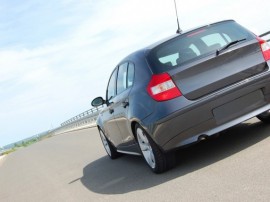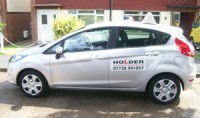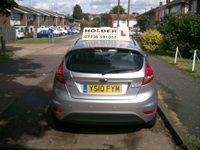These are basic safety checks that a driver should carry out to ensure the vehicle is safe for use.
Although some checks may involve the pupil opening the bonnet to identify where fluid levels would be checked, you will not be asked to touch a hot engine or physically check fluid levels.
As vehicle technology advances, more and more vehicles are being equipped with electronic diagnostic systems, which inform the driver of the state of the engine fluid levels and tyre pressures. It will be acceptable for a candidate to refer to the vehicle information system (if fitted) when answering questions on fluid levels or tyre pressures.
You will be asked two questions, one 'show me' and one 'tell me'. One or both questions answered incorrectly will result in one driving fault being recorded.
Tell Me Questions
Q1. Open the bonnet, identify where you would check the engine oil level and tell me how you would check that the engine has sufficient oil.
A. Identify dipstick/oil level indicator, then explain that you would remove the dipstick, wipe with a clean cloth, replace the dipstick fully, remove again and check oil level against the markers. This is best done when the vehicle has stood on level ground for more than 30 mins.
Q2. Open the bonnet, identify where you would check the engine coolant level and tell me how you would check that the engine has the correct level.
A. Identify high/low level markings on header reservoir tank or radiator filler cap, and describe how to top up to correct level.
Q3. Open the bonnet, identify where the brake fluid reservoir is, and tell me how you would check that you have a safe level of hydraulic brake fluid.
A. Identify reservoir, check level against high/low markings.
Q4. Identify where the windscreen washer reservoir is, and tell me how you would check the windscreen washer level.
A. Identify reservoir and explain how to check level and top up as necessary.
Q5. Tell me how you would check that the brakes are working before starting a journey.
A. Brakes should not feel spongy or slack (indicates low brake fluid). Brakes should be tested as you set off and the vehicle should not pull to one side.
Q6. Tell me where you would find the information for the recommended tyre pressures for this car and how tyre pressures should be checked.
A. Look in the manufacturer's guidebook or on the car door pillar, use a reliable pressure gauge, check and adjust pressures when tyres are cold, not forgetting the spare tyre and remember to refit dust valve caps afterwards.
Q7. Tell me how you would check the tyres to ensure that they have sufficient tread depth and that their general condition is safe to use on the road
A. No cuts or bulges, 1.6mm of tread depth across the central ¾ of the breadth of the tyre and around the entire outer circumference.
Q8. Tell me how you make sure your head restraint is correctly adjusted so it provides the best protection in the event of a crash.
A. The head restraint should be adjusted so the rigid part of the head restraint is at least as high as the eye or top of the ears, and as close to the back of the head as is comfortable. N.B. Some restraints might not be adjustable.
Q9. Tell me how you would know if there was a problem with your anti-lock braking system.
A. Warning light on the instrument panel (near speedometer) should illuminate if there is a fault with the anti-lock braking system.
Q10. Tell me how you would check that the headlights and tail lights are working (no need to exit the vehicle).
A. Explain how to operate light switch (turn on ignition if necessary), walk around vehicle checking each side light, dipped headlight and taillights. (As this is a 'Tell Me' question there is no need to physically check the lights).
Show Me Questions
Q11. Show me/explain how you would check that the power assisted steering is working before starting a journey.
A. If the steering becomes heavy the system may not be working properly. Before starting a journey two simple checks can be made. Gentle pressure on the steering wheel, maintained while the engine is started, should result in a slight but noticeable movement as the system begins to operate. Alternatively, turning the steering wheel just after moving off will give an immediate indication that the power assistance is functioning.
Q12. Show me how you would check that the direction indicators are working.
A. Press the hazard warning switch (which will operate all indicators) and walk around the vehicle to check functioning of all indicators.
Q13. Show me how you would check that the horn is working (off-road only).
A. Check is carried out by pressing the horn control on your steering wheel (turn on ignition if necessary).
Q14. Show me how you would check the parking brake (handbrake) for excessive wear, make sure you keep safe control of the vehicle.
A. Apply footbrake firmly. Demonstrate by applying parking brake (handbrake) that when it is fully applied it secures itself, and is not at the end of it's working travel, release the brake pedal to finish the demonstration.
Q15. Show me how you would check that the brake lights are working on this car. (I can assist you if you need to switch the ignition on, please don't start the engine).
A. Operate brake pedal, make use of reflections in windows, garage doors, another car bodies paintwork etc, or ask someone to look whilst you operate the brake pedal. (You may need to switch the ignition on but DO NOT start the engine).
Q16. Show me how you would clean the windscreen using the windscreen washer and wipers.
A. Operate control to wash and wipe windscreen (turn ignition on if necessary).
Q17. Show me how you would set the demister controls to clear all the windows effectively, this should include both front and rear screens.
A. Set all relevant controls including; fan, temperature, air direction/source and heated screen to clear windscreen and windows. (Engine does not have to be started for this demonstration).
Q18. Show me how you would switch on the rear fog light(s) and explain when you would use it/them. (No need to exit vehicle, Please don't start the engine.)
A. Operate switch (turn on dipped headlights and ignition if necessary). Check warning light is on. Explain use (you would switch the rear fog lights on when visibility is below 100m, otherwise it will dazzle the drivers behind).
Q19. Show me how you switch your headlight from dipped to main beam and explain how you would know the main beam is on whilst inside the car.
A. Operate switch (with ignition or engine on if necessary), check with main beam warning light which is coloured blue on the instrument panel.
Road to Driving
Provisional Driving Licence
Before you are able to drive you need to obtain a provisional driving licence, to do this you need to collect the application form from your local post office and send it back in the pre paid envelope to the Driver and Vehicle Licensing Agency (DVLA)
The Theory Test
The theory test must be passed before taking the practical exam, it is made up of a multiple choice part and a hazard perception part. Our driving instructors can advise and provide you with any support you may need before taking the theory test. To book the theory test you will need to contact the Driving Standards Agency (DSA)
The Practical Exam
The practical exam is also booked with the Driving Standards Agency (DSA)




